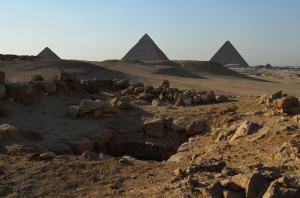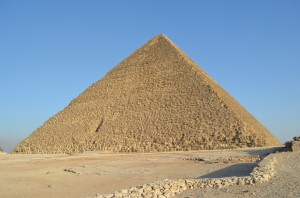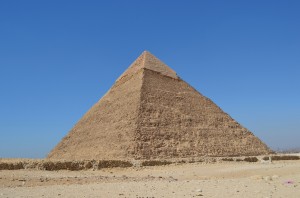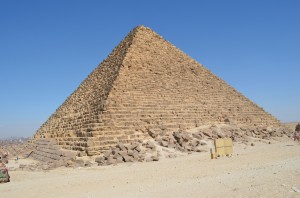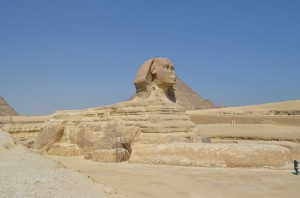GIZA (Egypt)
Comprehensive information about Giza Pyramids, the Sphinx and the underground structures can be found on the website GIZA LEGACY.
1.2 Power place
Names
– Gizeh, Giza, al Giza, (al-Jiza, Egyptian Arabic eg-Giza) al Quasir
– Giza approximates the Egyptian Arabic pronunciation.
In Standard Arabic, the word starts with the sound that in English is pronounced “j” (resulting in the occasional spelling of Jizah).
Geomancy
Bleak landscapes, crossed by limestone subsoil, which are very sandy, windy, dry and hot. Mild and fertile only along the Nile, though vegetation used to range as far as Giza and then again in the Nile Delta.
Despite the close proximity to Cairo, a metropolis of 18 million people, the power point is very palpable as a purifying, strengthening, transforming and uplifting force. Giza is located at the intersection of several grid lines and dimension levels. I know of no place that unites the old and new energies in this way.
Power point
The main power point in Giza is situated about 1.5 kilometers southeast of the pyramids in the desert near a buried megalithic shaft. The so-called Solar Cross marks the place as a center of power and as the origin of a Fibonacci spiral. When viewed from the perspective of the surface geometry, it is located at a key point. If a golden spiral is drawn through the apices of the three pyramids, then the center point of the spiral is located precisely where the Solar Cross is found. This is further evidence of the ingenious overall plan of this complex.
– Corresponds to: crown chakra, spirit
– Color: violet
– Dominating elements: air and fire
– Corresponding place: Rapa Nui, Easter Island
1.3 Main structures
The three megalithic pyramids and the Sphinx
(named after Cheops, Chephren and Mykerinos, or after the stars in the belt of Orion: Mintaga, Alnitag and Alnilam)
They are among most breathtaking wonders of the world, the three gigantic pyramids and the Sphinx, which sit on a slightly elevated rock plateau. Built with incredible precision, oriented exactly to the four points of the compass and to certain planets, based on mathematical formulas and geometric figures, which are incredible even for modern science, the Wonders of Giza remain a mystery. Egyptologists ascribe the pyramids to the Pharaonic dynasties (beginning about 3,000 BC) but there are many indications that they are considerably older and come from a civilization that existed long before our time.
As I documented in Volume I, GIZA LEGACY, to this day there are no credible theories or evidence in academic or technical journals that would explain how these gigantic, sophisticated structure could have been built in the time of the ancient Egyptians. Other sources assume that they originate from an even older advanced civilization which had greater knowledge.
Inside and beneath the pyramids in Giza there are many more passages and buildings than have been previously discovered and officially disclosed by the Egyptologists. Construction of the above ground structures began approximately 14,000 BC and was completed about 1,000 years later.
Some of the underground constructions are very likely even older and can be traced back to the Lemurians, an advanced civilization that preceded the Atlanteans.
Until about the 14th century AD, the Giza pyramids looked different than they do today. Originally, they were lined with special blocks which were cut on the outside at the angle of inclination of the pyramids. Blocks of light-colored Tura limestone were used to encase the Cheops Pyramid. The limestone quarries of Tura are situated on the opposite side of the Nile, nearly as far south as Saqqara. The bottommost three layers of the casing of the Pyramid of Chephren are made of pink granite transported from 1,000 kilometers away in Aswan. Tura limestone was then used for the rest. For the Pyramid of Mykerinos, also known as the red pyramid, the lower third of the outer coating was made of pink granite and the upper portion was also encased with Tura limestone.
Another amazing thing is the location of the pyramids and the knowledge which it implies: that the earth is a sphere. The “Cheops” pyramid is situated on the 30th parallel. It also sits on the line that, when followed around the globe, bisects the water and land surface.
Because the Cheops Pyramid is located at the 30th parallel, it is as equidistant from the center of the Earth and the North Pole. The position of the Cheops Pyramid is thus a geodetic fixed point, which could only have been calculated by someone who knew the Earth to be a sphere and who had measurements of both the landmasses and the oceans! The length of perimeter (including blocks) is 365.342 Egyptian cubits, which is exactly the number of days in a year.
The steep 52° angle of inclination indicates the incorporation of the number π, because the height of the original pyramid, at 146.72 meters, has the same ratio to the base, at 921.44 meters, as does the radius of a circle to its circumference (2 x π). The pyramid is thus also a projection of the northern hemisphere.
“The apex represented the pole and the perimeter [at the base] represented the equator. This is the reason why the perimeter is in relation 2 pi to the height.”
(Hancock – 1.1)
This is just a small excerpt from the book GAIA LEGACY.
1. GIZA (Egypt)
1.1 Landscape 73
– Geography 73
– Geology 73
– Vegetation 74
– Climate 74
1.2 Power point 75
– Names 75
– Geomancy 75
– Power point 75
1.3 Constructions 76
– Main structures 76
– Subterranean structures 89
– Other structures in the region 91
– Temple structures 93
1.4 History 97
– Historical History 97
– Finds 98
– Prehistoric history 102
– Builders and peoples 110
– Original purpose 110
– Legends and myths 111
1.5. Spirit 120
– Religions and deities 120
– Spirituality and transmissions 124

